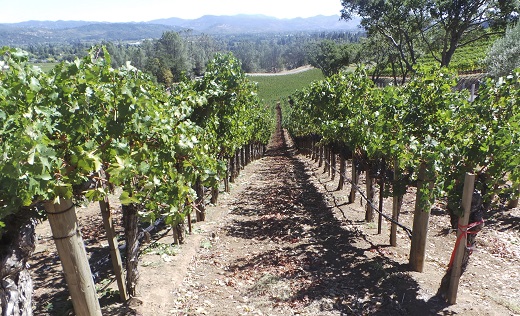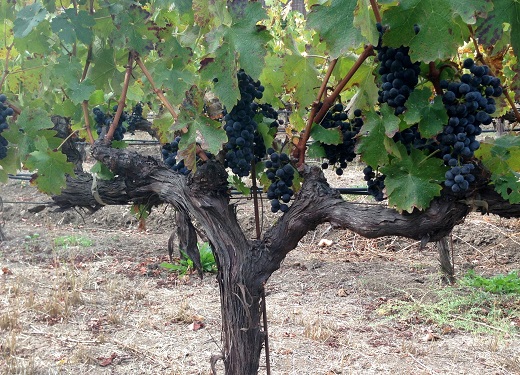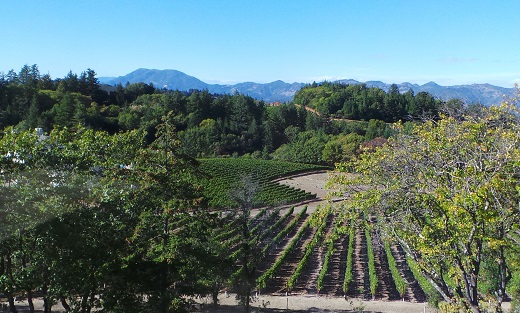Browse using the new Vinous website now. Launch →
Printed by, and for the sole use of . All rights reserved © 2015 Vinous Media
2010 Napa Valley Cabernet Sauvignon: An Epic Vintage
by Antonio Galloni
Fans of Napa Valley Cabernet Sauvignon will find a lot to get excited about with the 2010 vintage. The 2010s are magnificent, viscerally thrilling wines loaded with character and personality. To be sure, the 2010s – the product of a long, cold growing season – are going to require a few years in bottle. This is the type of vintage that is often overlooked upon release, but that consumers regret not purchasing more deeply when the wines start showing their full potential 4-5 years later. There is no question 2010 is the greatest vintage for Napa Valley Cabernet Sauvignon in the 2008-2011 time frame.
The 2010 Cabernet Sauvignons
Up until 2011, 2010 was the longest and coldest growing season many producers had ever seen. The summer was quite cold, which tempted some winemakers to de-leaf, a big mistake when an unexpectedly long and brutal heat wave arrived towards the end of the season. Where growers were more prudent, the wines are utterly brilliant, with deep colors, precise fruit, ripe tannins and expressive aromatics. Because the growing season was so long, the vines achieved full phenolic maturity, which gave the tannins a level of textural elegance that is unusual in such big wines. At the same time, there is plenty of California richness, something Napa Valley has no problem producing in abundance. In other words, the best 2010s also possess stunning harmony. The superiority of the 2010s vis-à-vis the 2009s is increasingly clear, in that the 2010s have much more finessed tannins, richer fruit and better balance. Another feature of the 2010s is that the wines are very site-specific, in other words, they are steeped in terroir. Yes, terroir does exist in California. More on that below.
Readers should do whatever they can to source the best 2010s, as they are magnificent. The top wines will reward cellaring and be long-lived. The weak spot for 2010 is the mountains, where the fruit didn’t ripen as well in all sites. In many places, the 2009s are superior to the 2010s, so a little more selectivity is required when looking at the 2010 Cabernets from mountain vineyards.
On the subject of the 2009 Cabernet Sauvignons, many wines have firmed up since I tasted them last year. The 2009s were largely picked in advance of inclement weather that was on the horizon in mid October. As a result, there is a firmness in the tannin in many wines that suggests phenolic ripeness was lower than in 2010. I am not sure if the 2009s are closing down in bottle, or if the quality of the tannin is simply becoming more evident, but I suspect that is a case-by-case assessment.

Above: Madrona Ranch, St. Helena
2011 On the Horizon
Few subjects are as divisive among winemakers in Napa Valley than the 2011 vintage. It was by far the most difficult vintage in several decades, starting with huge rain during the flowering, miserable weather during the summer and conditions that seemed to change every five minutes during harvest. Yields were minuscule. Winemakers were shocked by the velocity with which botrytis spread in Cabernet vineyards, a phenomenon many winemakers had never even seen before. Severe sorting in the vineyards and then in the cellar was absolutely essential. As for the wines, they are naturally all over the place. But there are also a handful of great wines, especially on Howell Mountain, which lies above the fog and therefore was able to dry out the rain. The same thing goes for a number of well-drained sites on the valley floor. Vine Hill Ranch and Las Piedras come to mind. The bottom line is that readers will have to be selective with 2011, but the vintage is certainly not a total wash. I tasted fewer 2011s this year than 2010s last year because the malolactic fermentations were slower in 2011, and therefore the wines were in a much more awkward state at the time of my fall tastings. It is also clear that winemakers will be adding some of the abundant and higher quality 2012 juice to bolster the 2011s, so I will not be surprised if some of the wines I tasted are a little richer next year. Readers who want to learn more about the vintage might want to check out my 2011 Napa Preview article on our website.
How Great is 2012?
Hype over the 2012 vintage has been building over at least the last few months. It was a nearly perfect growing season on paper, with the exception of a few heat spikes at the end of September that came as a surprise. After three difficult years of well below normal yields, growers were begging for an abundant harvest, and they got it in 2012. The quality of the wines remains to be seen. To be sure, some producers allowed their plants to be a little more productive than normal. In more than a few spots, the vines seemed literally covered in a tapestry of fruit. Most winemakers are very enthusiastic, although some are more sanguine, as they understand it will take a far greater effort to make a distinguished wine in a vintage where everyone can make a great wine, as opposed to a year like 2011, which really separates the cream from the rest. Others are quite aware that yields were too high in some places to make truly distinguished wines. I will be tasting the 2012s next spring and will have an update shortly thereafter.

Above: Helms Vineyard, Dana Estates, Rutherford
I imagine most consumers think of Napa Valley as consisting of Highway 29 and the Silverado Trail, and the vineyards that are visible from both roads. The reality is that Napa Valley is a huge region encompassing an enormous variety of terroirs, the collective knowledge of which is still very much in its infancy. If I think about some of the vineyards I visited just in the last twelve months - Diamond Creek, Bill Harlan’s Promontory, the summit of Pritchard Hill, Sloan - all of which are well out of public view, each of these sites encompasses a level of variety that is truly mind-boggling. Yes, terroir exists in Napa Valley, and 2010 is a great vintage through which to experience the valley’s numerous microclimates, terrains and exposures.

Above: Vineyard 7 & 8, Spring Mountain
Napa Valley’s ‘Super-Seconds’
There is no way to ignore it, prices for Napa Valley’s top wines are high. Screaming Eagle is $850 a bottle, a 13% increase, the 2009 Harlan Estate is $750 a bottle, a whopping increase of 50% over the 2008. Napa Valley’s top estates now face the same problem as Bordeaux; the wines have become too expensive for restaurant wine lists. A $500 bottle at the standard 2.5- restaurant markup is, well, you can do the math. That is not a business with a sustainable future, at least not in this country and in this generation. At the same time, producers know they have to have a presence on restaurant wine lists, hence the explosion over the last few years of wines that retail in the $80-90 price range and that can therefore be sold in restaurants for around $250, still a lot of money, but doable. The best of these wines, which I call Napa Valley ‘Super-Seconds’ are in fact, super. In top vintages, the best second-wines from top wineries are better than the vast amount of main labels. These are my favorite ‘Super-Seconds.’ All but two retail for less than $100.
Napa Valley’s Best ‘Super-Seconds’
Araujo Altagracia
Blankiet Prince of Hearts
Bryant DB 4
Dominus Napanook
Futo OV
Harlan Estate The Maiden
Screaming Eagle Second Flight
Other Reliably Outstanding Sub-$100 Napa Valley Cabernet Sauvignons
Top-flight Napa Valley Cabernet is rarely inexpensive. These are some of my favorite sub-$100 wines. Many of these are available for well under $100.
Anderson’s Conn Valley
Beringer
Chappellet Signature
Corison
David Arthur
Drinkward Peschon
Kapcsandy Endre
Karen Culler/La Palette
Dunn
Kelly Fleming
Forman
Larkmead
Lail Blueprint
Cliff Lede
Nickel & Nickel Kelham
Joseph Phelps
O’Shaughnessy
Pierson Meyer
Priest Ranch
Ridge (Santa Cruz Mountains)
Rivers-Marie
Shafer One Point Five
Snowden
Philip Togni
Cover: Bryant Family Vineyards, Pritchard Hill
Show all the wines (sorted by score)
- Abreu
- Acacia Vineyard
- Adler Deutsch
- Ad Vivum
- Alpha Omega
- Amuse Bouche Winery
- Anderson's Conn Valley Vineyards
- Anthem
- Antica Napa Valley - Antinori Family Estate
- Araujo Estate Wines
- Arietta
- Aril Wines
- ARNS
- Atalon Winery
- Au Sommet
- Auteur
- Axios
- Bacio Divino
- Baldacci Family Vineyards
- Barlow Vineyards
- Barnett Vineyards
- Barrett & Barrett
- B Cellars
- Beaulieu Vineyard
- Beau Vigne
- Behrens Family Winery
- Beringer Vineyards
- Bevan Cellars
- Big Vine
- Black Cordon Vineyards
- Blankiet Estate
- Bond
- Bounty Hunter Rare Wine
- Brand Estate
- Brandlin
- Bridesmaid
- Bryant Family Vineyard
- Buccella
- Buehler Vineyards
- Buoncristiani Family Winery
- Bure Family Wines
- Cabaud Wines
- Cade
- Calera
- Capiaux
- Cardinale
- Carte Blanche
- Carter Cellars
- Carver Sutro
- Casa Piena
- Castello di Amorosa
- Caymus Vineyards
- Chappellet
- Chateau Boswell
- Chateau Montelena
- Chiarello Family Vineyards
- Chimney Rock Winery
- Cimarossa
- Clark-Claudon Vineyards
- Cliff Lede Vineyards
- Clos Du Val
- Clos Pegase
- Coho
- Colgin
- CONSTANT
- Continuum
- Corison
- Corra
- Crocker & Starr
- Culler
- Dalla Valle
- Dana
- Dancing Hares
- David Arthur Vineyards
- Davies Vineyards
- Derenoncourt California
- Detert Family Vineyards
- Diamond Creek Vineyards
- Domaine Chandon
- Dominus
- Drinkward-Peschon
- D. R. Stephens Estate
- Dunn Vineyards
- Dyer Vineyard
- Edge Hill
- Elyse Winery
- Entre-Nous (Kristine Ashe)
- ERBA
- Etude
- Fama
- Farella
- Favia
- Fiftyrow
- Fisticuffs
- Forman
- Franciscan Estate
- Frank Family Vineyards
- Frazier Winery
- Freemark Abbey
- Futo
- Gallica
- Gandona Estate
- Gemstone
- Girard Winery
- Grassi Wine Company
- Hall
- Harbison
- Harlan Estate
- Harris Estate Vineyards
- Hayfork
- Hendry
- Hollywood & Vine Cellars
- Honig Vineyard & Winery
- Howell at the Moon
- Hudson Vineyards
- Hundred Acre
- Hunnicutt
- Hyde De Villaine
- Inglenook
- Jacquelynn
- JD
- Joel Gott Wines
- Jones Family Vineyards
- Joseph Phelps Vineyards
- Juslyn Vineyards
- Kalaris
- Kapcsándy Family Winery
- Kazmer & Blaise
- Keenan Winery
- Keever
- Kelly Fleming Wines
- Kenefick Ranch
- Knighton Family Vineyards
- Kobalt
- Kongsgaard
- Krupp Brothers
- Ladera Vineyards
- Lagier Meredith
- Lail Vineyards
- La Jota Vineyard
- Larkmead Vineyards
- La Sirena
- Layer Cake
- Levy & McClellan
- Lewelling Vineyards
- Lindstrom
- Lokoya
- Louis M. Martini
- Macauley Vineyard
- Magie Rouge
- Ma(i)sonry
- Mark Herold Wines
- Maybach
- Maze
- Merryvale Vineyards
- Merus
- Meteor Vineyard
- Michael Mondavi Family Wines
- Molnar Family
- Montagna
- Moone-Tsai
- Morlet Family Vineyards
- Mt. Brave
- Myriad Cellars
- Nickel & Nickel
- Notre Vin
- Oakville Ranch
- O'Brien Estate
- O'Shaughnessy
- Outpost
- Ovid
- Pahlmeyer
- Palmaz
- Paratus
- Patel
- Paul Hobbs
- Paul Hobbs - Crossbarn
- Peacock Family
- Peirson Meyer
- Peter Franus Wine Company
- Philip Togni Vineyard
- Pied a Terre
- PlumpJack
- Pott Wine
- Pride
- Promise
- Pulido-Walker
- Quixote Winery
- Realm
- Retro Cellars
- Revana Family Vineyard
- Rivers-Marie
- Road 31
- Robert Biale Vineyards
- Robert Craig Winery
- Robert Mondavi Winery
- Round Pond Estate
- Roy Estate
- Rudd Oakville Estate
- Saddleback
- Sbragia Family Vineyards
- Scarecrow
- Schrader
- Screaming Eagle
- Seaver Vineyards
- Seavey
- Sequoia Grove Winery
- Seven Stones Winery
- Shafer Vineyards
- Signorello Estate
- Sloan Estate
- Snowden
- Somerston Estate
- Spottswoode
- Staglin Family Vineyard
- Stag's Leap Wine Cellars
- St. Clement Vineyards
- Stewart Cellars
- Stone The Crows
- Stormy Weather
- Tetra
- The Vineyardist
- Three Clicks
- Tofanelli
- Tom Eddy Winery
- TOR
- Trefethen Family Vineyards
- Trinchero Napa Valley
- Turley
- Venge Vineyards
- VHR, Vine Hill Ranch
- Vineyard 29
- Vineyard 7 & 8
- VinRoc Wine Caves
- Wallis Family Estate
- William Hill
- Young Inglewood
